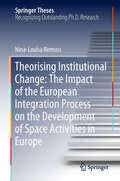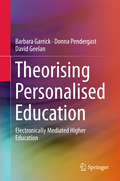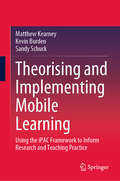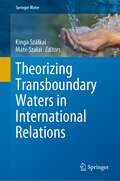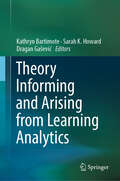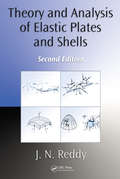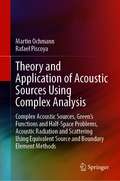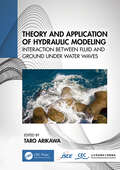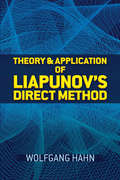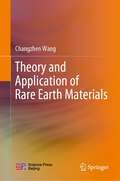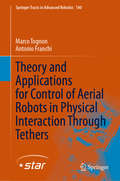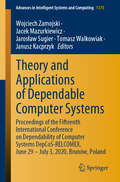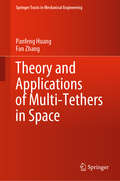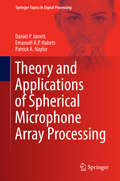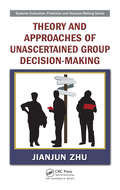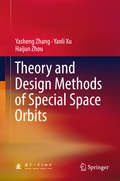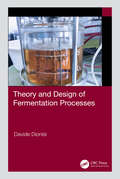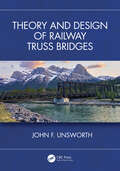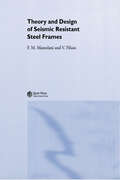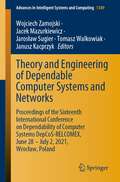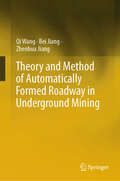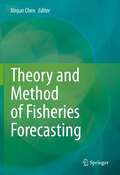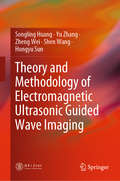- Table View
- List View
Theorising Institutional Change: The Impact of the European Integration Process on the Development of Space Activities in Europe (Springer Theses)
by Nina-Louisa RemussThe book provides a structural analysis of the European space effort from an institute change perspective. It analyzes the EU-ESA inter-institutional relationship, gives an overview of the development of space policy in Europe, and advances the debate about the impact of the European integration process on existing institutional actors. While European Space collaboration was initially developed outside the competences of the European Union (EU) with space programmes being carried out almost exclusively under the framework of European Space Agency (ESA) and national agencies, the EU has gained “shared competences” (Art. 2, TFEU) in space policy following the adoption of the Lisbon Treaty. Currently the EU and ESA work together under a Framework Agreement. In 2016, the EU Commission has published a Communication entitled “European Space Policy” (ESP). Even though ESA’s Member States have agreed to keep ESA as an intergovernmental organisation during the ESA Ministerial Council of 2014, the discussion about ESA becoming part of the EU framework continues. The EU’s ambitions for leadership in European space policy raise question concerning the future of ESA. The study of institutions lies at the heart of political sciences. Strikingly the theoretic framework qualifying institutional change and making it comparable leaves room for more concrete and testable dimensions of institutional change.
Theorising Personalised Education
by Barbara Garrick Donna Pendergast David GeelanThis book examines the theoretical underpinning of the concept of personalised education and explores the question: What is personalised education in the contemporary higher education sector and how is it implemented? A broad, sophisticated definition of personalised learning has the potential to serve as a basis for more effective educational practices. The term 'personalised education' is, and continues to be, one with a variety of definitions. The authors' definition both incorporates earlier concepts of personalised education and critically reassesses them. The book then adds a further dimension: personalised instruction in electronically mediated environments, where the goal is to achieve learning towards mastery individually with the help of differentiated and individualised electronic learning platforms. This book assesses the various arguments concerning personalised education, examining each through the lens of educational theory and pedagogy and subsequently positing a number of qualitative characteristics of personalised education that have the potential to influence policy and practices in the higher education sector.
Theorising and Implementing Mobile Learning: Using the iPAC Framework to Inform Research and Teaching Practice
by Sandy Schuck Kevin Burden Matthew KearneyThis book focuses on teaching and learning with mobile technologies, with a particular emphasis on school and teacher education contexts. It explains a robust, highly-acclaimed contemporary mobile pedagogical framework (iPAC) that focuses on three distinct mobile pedagogies: personalisation, authenticity and collaboration. The book shows how mobile pedagogical practice can benefit from use of this framework. It offers numerous cutting-edge research resources and examples that supplement theoretical discussions. It considers directions for future research and practice. Readers will gain insights into the potential of current and emerging learning technologies in school and teacher education.
Theorizing Transboundary Waters in International Relations (Springer Water)
by Máté Szalai Kinga SzálkaiThis book is the first collection of state-of-the-art research projects analyzing water conflict and cooperation with an explicitly theoretical point of view. Its fourteen chapters offer a comprehensive and up-to-date overview on how the application of various theoretical perspectives can support the work of scholars and practitioners in mitigating water conflict and developing cooperation.The volume starts out from a literature review on the theorization of transboundary waters in International Relations, which prepares the ground for the demonstration of the latest approaches of scholars currently working on this field. The discussion of their findings is divided into four main sections. The first section deals with reflections and critiques on the grand theories of International Relations, proposing new and more nuanced frameworks for understanding and managing transboundary water relations by going beyond the traditional assumptions. The second section focuses on the catalysts and barriers of cooperation, applying theoretical frameworks which reveal the consequences of the dynamics in power relations and institutional frameworks. The third section investigates into the perspectives at the intersections of theory and practice related to the most practical field within the scope of the volume: water diplomacy. The fourth section introduces new perspectives to provide specific entry points for understanding and managing water conflict and cooperation.Overall, the work intends to demonstrate that the theorization of transboundary waters can significantly contribute to the deeper understanding and the more efficient management of water conflicts and cooperation from several aspects.The authors come from diverse backgrounds, and their individual careers are often related to the intersections of theory and practice in the field of transboundary water management. Their expertise covers water issues from all around the globe, which is reflected in the range of the analyzed case studies. The diversity of the experts involved, their backgrounds, their perspectives, the applied theories, and the analyzed cases was an important priority for the editors.
Theory Informing and Arising from Learning Analytics
by Kathryn Bartimote Sarah K. Howard Dragan GaševićTheory Informing and Arising from Learning Analytics delves into the dynamic intersection of learning theory and educational data analysis within the field of Learning Analytics (LA). This groundbreaking book illuminates how theoretical insights can revolutionize data interpretation, reshape research methodologies, and expand the horizons of human learning and educational theory. Organized into three distinct sections, it offers a comprehensive introduction to the role of theory in LA, features contributions from leading scholars who apply diverse theoretical frameworks to their research, and explores cutting-edge topics where new theories are emerging. A standout feature is the inclusion of three “in conversation” chapters, where expert panels dive into the topics of ethics, self-regulated learning, and qualitative computation, enriched by accompanying podcasts that provide fresh, thought-provoking perspectives. This book is an invaluable resource for researchers, sparking debates on the evolving role of theory in LA and challenging conventional epistemological views. Published by Springer, it is an essential read for both aspiring and seasoned scholars eager to engage with the forefront of LA research.
Theory and Analysis of Elastic Plates and Shells (Series in Systems and Control)
by J. N. ReddyBecause plates and shells are common structural elements in aerospace, automotive, and civil engineering structures, engineers must understand the behavior of such structures through the study of theory and analysis. Compiling this information into a single volume, Theory and Analysis of Elastic Plates and Shells, Second Edition presents a complete
Theory and Application of Acoustic Sources Using Complex Analysis: Complex Acoustic Sources, Green’s Functions and Half-Space Problems, Acoustic Radiation and Scattering Using Equivalent Source and Boundary Element Methods
by Martin Ochmann Rafael PiscoyaThis book highlights the mathematical and physical properties of acoustical sources with singularities located in the complex plane and presents the application of such special elements to solve acoustical radiation and scattering problems. Sources whose origin lies in the complex plane are also solutions of the wave equation but possess different radiating properties as their counterparts with real positions. Such mathematical constructions are known in the fields of optics and electrodynamics, but they are not common in acoustical research. The objective of the book is to introduce this concept to acousticians and motivate them to engage themselves in further research and application of complex sources. Such sources are particularly useful to formulate Green’s functions and related equivalent source and boundary element methods in half-spaces.
Theory and Application of Hydraulic Modeling: Interaction between Wave and Ground Motion
by Taro ArikawaThis edited volume from Japan’s Research Subcommittee on Methodology for Dealing with Geomaterials in Hydraulic Model Experiments presents readers with a state-of-the-art overview of experimental and computational methods used to address similarity scaling incompatibilities present in fluid–sediment flows.Readers will gain an understanding of complex phenomena in the boundary fields of hydraulics and geotechnical engineering. Chapter contributors focus on the phenomena that are affected by the interactions between fluid wave and ground in a complex field, which for many years have been challenging to process and model. In addition to describing the implementation of model tests and the concept of the law of similarity, this book contrasts these phenomena with the laws of similarity, describes models and numeral analysis methods, and explains important considerations using experimental case studies. Each chapter is written by leading researchers in Japan who are members of the Research Subcommittee on Methodology for Dealing with Geomaterials in Hydraulic Model Experiments. The chapters are closely linked but are written so that each can be read individually. Readers will be able to apply this knowledge to their work and to create models that more accurately simulate the interactions between wave and ground, allowing them to better understand these phenomena and devise more appropriate strategies for defense and so on when necessary.This collection provides information that can be used by young researchers and post-graduate students in the boundary fields of hydraulics and geotechnical engineering who aim at becoming civil engineers, and it will be of particular value to practicing engineers of all experience levels who must regularly analyze complex interactions between fluids and ground.
Theory and Application of Liapunov's Direct Method (Dover Books on Mathematics)
by Wolfgang HahnThe groundbreaking work of Russian mathematician A. M. Liapunov (1857–1918) on the stability of dynamical systems was overlooked for decades because of political turmoil. During the Cold War, when it was discovered that his method was applicable to the stability of aerospace guidance systems, interest in his research was rekindled. It has remained high ever since.This monograph on both the theory and applications of Liapunov's direct method reflects the work of a period when the theory had been studied seriously for some time and reached a degree of completeness and sophistication. It remains of interest to applied mathematicians in many areas. Topics include applications of the stability theorems to concrete problems, the converse of the main theorems, Liapunov functions with certain properties of rate of change, the sensitivity of the stability behavior to perturbations, the critical cases, and generalizations of the concept of stability.
Theory and Application of Rare Earth Materials
by Changzhen WangThis book starts with a theoretical introduction of the rare earth materials, and it subsequently analyzes the essential characteristics of these materials from elements, compounds to physical chemistry and metal materials, etc. Under the supplementary explanation of experimental data and results, the research is gradually guided into the multi-domain application scene. Through extensive analyses, this book displays comprehensively the distinguished values of the rare earth materials and the theoretical, empirical, and practical significance of rare earth materials is unraveled. It also covers an exhaustive review of 17 rare earth elements, their characteristics, and more possibilities in physical chemistry, functional materials, metallurgy, composites and engineering, and their prospects in production and technical applications. In-depth account of the whole spectrum of rare earth material research makes this book a unique reference to academic researchers, students, and engineers.
Theory and Applications for Control of Aerial Robots in Physical Interaction Through Tethers (Springer Tracts in Advanced Robotics #140)
by Marco Tognon Antonio FranchiThis book studies how autonomous aerial robots physically interact with the surrounding environment. Intended to promote the advancement of aerial physical interaction, it analyzes a particular class of aerial robots: tethered aerial vehicles. By examining specific systems, while still considering the challenges of the general problem, it will help readers acquire the knowledge and expertise needed for the subsequent development of more general methods applicable to aerial physical interaction.The formal analysis covers topics ranging from control, state estimation, and motion planning, to experimental validation. Addressing both theoretical and technical aspects, the book is intended for a broad academic and industrial readership, including undergraduate students, researchers and engineers. It can be used as a teaching reference, or as the basis for product development.
Theory and Applications of Dependable Computer Systems: Proceedings of the Fifteenth International Conference on Dependability of Computer Systems DepCoS-RELCOMEX, June 29 – July 3, 2020, Brunów, Poland (Advances in Intelligent Systems and Computing #1173)
by Janusz Kacprzyk Wojciech Zamojski Jacek Mazurkiewicz Jarosław Sugier Tomasz WalkowiakThis book presents selected papers from the Fifteenth International Conference on Dependability of Computer Systems (DepCoS-RELCOMEX), which illustrate the diversity of theoretical problems in analysis of performability, reliability and security of contemporary computer systems. Covering also methodologies and practical tools involved in this field, it is a valuable reference resource for scientists, researchers, practitioners and students who are dealing with these subjects.Established in 2006, DepCoS-RELCOMEX is an annual conference series organised by Wrocław University of Science and Technology. It focuses on the dependability and performability of contemporary computer systems – topics that can provide solutions to new challenges in evaluation of their reliability and efficiency. Since they are probably the most complex technical systems ever engineered by humans, the organization of modern computer systems cannot be modelled and analysed solely as structures (however complex and distributed) built only on the basis of technical resources. Instead they should be considered as a unique blend of interacting people (their needs and behaviours), networks (together with mobile properties, iCloud organisation, Internet of Everything) and a large number of users dispersed geographically and producing an unimaginable number of applications. This new, interdisciplinary approach is developing a continually increasing range of methods which apply also the latest findings in artificial intelligence (AI) and computational intelligence (CI).
Theory and Applications of Multi-Tethers in Space (Springer Tracts in Mechanical Engineering)
by Fan Zhang Panfeng HuangThis book offers a comprehensive overview of recently developed space multi-tethers, such as maneuverable space tethered nets and space tethered formation. For each application, it provides detailed derivatives to describe and analyze the mathematical model of the system, and then discusses the design and proof of different control schemes for various problems. The dynamics modeling presented is based on Newton and Lagrangian mechanics, and the book also introduces Hamilton mechanics and Poincaré surface of section for dynamics analysis, and employs both centralized and distributed controllers to derive the formation question of the multi-tethered system. In addition to the equations and text, it includes 3D design drawings, schematic diagrams, control scheme blocks and tables to make it easy to understand. This book is intended for researchers and graduate students in the fields of astronautics, control science, and engineering.
Theory and Applications of Spherical Microphone Array Processing
by Emanuël A.P. Habets Daniel P. Jarrett Patrick A. NaylorThis book presents the signal processing algorithms that have been developed to process the signals acquired by a spherical microphone array. Spherical microphone arrays can be used to capture the sound field in three dimensions and have received significant interest from researchers and audio engineers. Algorithms for spherical array processing are different to corresponding algorithms already known in the literature of linear and planar arrays because the spherical geometry can be exploited to great beneficial effect. The authors aim to advance the field of spherical array processing by helping those new to the field to study it efficiently and from a single source, as well as by offering a way for more experienced researchers and engineers to consolidate their understanding, adding either or both of breadth and depth. The level of the presentation corresponds to graduate studies at MSc and PhD level. This book begins with a presentation of some of the essential mathematical and physical theory relevant to spherical microphone arrays, and of an acoustic impulse response simulation method, which can be used to comprehensively evaluate spherical array processing algorithms in reverberant environments. The chapter on acoustic parameter estimation describes the way in which useful descriptions of acoustic scenes can be parameterized, and the signal processing algorithms that can be used to estimate the parameter values using spherical microphone arrays. Subsequent chapters exploit these parameters including in particular measures of direction-of-arrival and of diffuseness of a sound field. The array processing algorithms are then classified into two main classes, each described in a separate chapter. These are signal-dependent and signal-independent beamforming algorithms. Although signal-dependent beamforming algorithms are in theory able to provide better performance compared to the signal-independent algorithms, they are currently rarely used in practice. The main reason for this is that the statistical information required by these algorithms is difficult to estimate. In a subsequent chapter it is shown how the estimated acoustic parameters can be used in the design of signal-dependent beamforming algorithms. This final step closes, at least in part, the gap between theory and practice.
Theory and Approaches of Unascertained Group Decision-Making (Systems Evaluation, Prediction, And Decision-making Ser.)
by Jianjun ZhuTackling the question of how to effectively aggregate uncertain preference information in multiple structures given by decision-making groups, Theory and Approaches of Unascertained Group Decision-Making focuses on group aggregation methods based on uncertainty preference information. It expresses the complexity existing in each group decision-maki
Theory and Design Methods of Special Space Orbits
by Yasheng Zhang Yanli Xu Haijun ZhouThis book focuses on the theory and design of special space orbits. Offering a systematic and detailed introduction to the hovering orbit, spiral cruising orbit, multi-target rendezvous orbit, initiative approaching orbit, responsive orbit and earth pole-sitter orbit, it also discusses the concept, theory, design methods and application of special space orbits, particularly the design and control method based on kinematics and astrodynamics. In addition the book presents the latest research and its application in space missions. It is intended for researchers, engineers and postgraduates, especially those working in the fields of orbit design and control, as well as space-mission planning and research.
Theory and Design of Digital Communication Systems
by Tri T. HaHa (electrical and computer engineering, Naval Postgraduate School, Monterey, California) presents a textbook with material for two one-semester courses in digital communications. The first is for senior undergraduate students who have completed an introductory communications course that is heavy on analog communications. The second course is for graduate students who have a firm background in random variables and processes. The practical material might be helpful as well for practitioners and professionals in digital communications, he says, especially in commercial and military applications. His topics include deterministic and random signal analysis, information theory and channel coding, modulation and demodulation, intersymbol interference and equalization, and fading channels. Annotation ©2011 Book News, Inc. , Portland, OR (booknews. com)
Theory and Design of Fermentation Processes
by Davide DionisiThe book covers the kinetics and design of fermentation processes, defined in the broader sense as any industrial processes that use living microorganisms or cells, both under aerobic and anaerobic conditions. It starts with a concise introduction to microbes and their metabolism, followed by rate equations, stoichiometry, derivation and use of mass balances for the design processes. It covers oxygen transfer and mass balances, heat transfer and design and scale-up/scale-down of fermentation processes. It further includes industrially relevant process examples, over 100 solved examples, questions and problems, and solutions of differential equations and systems of equations in Excel. Features Uses chemical engineering principles for the study of fermentation processes Provides detailed coverage of stoichiometry and kinetics of fermentation processes Discusses pertinent oxygen transfer theory and its applications Concisely covers microorganisms’ biochemistry and metabolism Includes solved examples and problems with solutions This book is designed as a textbook for undergraduate students in chemical engineering; however, it is also suitable for postgraduate students and for process engineers interested in these topics.
Theory and Design of Railway Truss Bridges
by John F. UnsworthRailroad bridges are a critical component of the infrastructure and economy of many countries, and many of these bridges are nearing the end of their useful service life. Theory and Design of Railway Truss Bridges provides comprehensive coupled information regarding the structural analysis and design of steel railway truss spans. Most books cover either analysis or design of structures, but none cover both the analysis and design of railway trusses. Further, the book presents technical information on the analysis of railway trusses currently unavailable in other modern books. It also provides readers with up-to-date information concerning the modern methods of design recommended by the American Railway Engineering and Maintenance-of-Way Association (AREMA): Includes detailed information on the analysis of trusses for moving loads. Presents information on topics specific to railway trusses such as loading effects, secondary stresses and stress reversal. Includes information on the history of railway truss analysis, design and construction. Covers methods for the analysis of statically indeterminate spans. Describes methods to determine the displacement of truss spans. Provides up-to-date theory and design methods based on current AREMA recommendations.
Theory and Design of Seismic Resistant Steel Frames
by Federico Mazzolani Vincenzo PilusoA state-of-the-art summary of recent developments in the behaviour, analysis and design of seismic resistant steel frames. Much more than a simple background volume, it gives the most recent results which can be used in the near future to improve the codified recommendations for steel structures in seismic zones. It contains new material which cann
Theory and Design of Terabit Optical Fiber Transmission Systems
by Stefano BottacchiThis comprehensive, modular treatment of the challenging issues involved in very high-speed optical transmission systems contains all the theory and practical design criteria required to optimise transmission system design. Each chapter covers the theoretical modelling of a given system; chapters are well supported by real-world worked examples and accompanied by MATLAB code and receiver design examples. Critical analysis and comparison of engineering solutions is presented, to make clear the principles underlying system performance optimisation, and a broad range of transmission systems is discussed, including the status and performance demands of the Terabit systems now entering the next generation market. Blending theoretical and practical considerations for high-speed fibre optic systems design, this is an indispensable reference for all forward-looking professionals and researchers in optical communications.
Theory and Engineering of Dependable Computer Systems and Networks: Proceedings of the Sixteenth International Conference on Dependability of Computer Systems DepCoS-RELCOMEX, June 28 – July 2, 2021, Wrocław, Poland (Advances in Intelligent Systems and Computing #1389)
by Janusz Kacprzyk Wojciech Zamojski Jacek Mazurkiewicz Jarosław Sugier Tomasz WalkowiakThis book contains papers on selected aspects of dependability analysis in computer systems and networks, which were chosen for discussion during the 16th DepCoS-RELCOMEX conference held in Wrocław, Poland, from June 28 to July 2, 2021. Their collection will be a valuable source material for scientists, researchers, practitioners and students who are dealing with design, analysis and engineering of computer systems and networks and must ensure their dependable operation.Being probably the most complex technical systems ever engineered by man (and also—the most dynamically evolving ones), organization of contemporary computer systems cannot be interpreted only as structures built on the basis of (unreliable) technical resources. Their evaluation must take into account a specific blend of interacting people (their needs and behaviours), networks (together with mobile properties, cloud organization, Internet of Everything, etc.) and a large number of users dispersed geographically and constantly producing an unconceivable number of applications. Ever-growing number of research methods being continuously developed for dependability analyses apply the newest techniques of artificial and computational intelligence. Selection of papers in these proceedings illustrates diversity of multi-disciplinary topics which are considered in present-day dependability explorations.
Theory and Method of Automatically Formed Roadway in Underground Mining
by Qi Wang Bei Jiang Zhenhua JiangThis book investigates in detail the theory and method of automatically formed mining roadway (AFR). The AFR method utilizes mining pressure and broken expansion characteristics of the collapsed rock mass in the gob to automatically form roadways, which changes the traditional “long cantilever beam” to “short cantilever beam” structure, and eliminate roadway excavation and coal pillar reserve. Key technologies are developed under the guidance of the “equilibrium mining” theory, such as in situ drilling and zoning technology, roof directional presplitting technology, high prestressed constant-resistance support technology, and gangue blocking support technology. The mining technologies and methods are successfully applied to a large number of coal mines of different geological conditions. The book is intended for both researchers and practitioners working in the mining, civil, and geological engineering fields.
Theory and Method of Fisheries Forecasting
by Xinjun ChenThis book systematically introduces the knowledge system and research results of fisheries forecasting. It is divided into four parts and seven chapters. The first part is the introduction, which mainly introduces the basic concepts, the nature of the subject, and the research contents, as well as the current status of research. The second part is about the basic knowledge of fisheries forecasting, including overview of the world marine environment, fish shoaling and migration distribution, the relationship between fish behavior and marine environment, and the basic theory of forming fishing ground. The third part is the focus of this book, including the basic principles and methods of fisheries forecasting, as well as the application of new techniques and methods in fisheries forecasting. The fourth part is the comprehensive application of fisheries forecasting, including the general situation of world marine fisheries, the impact of global marine environment changes on fisheries resources and fishing ground, and case studying of fisheries forecasting of important economic species, such as oceanic squid, jack mackerel, anchovy, and skipjack. The study of this book will help everyone to master the basic principles and methods of fisheries forecasting, as well as the application of new technologies and methods in important economic species, and lay a foundation for future work in the field of marine fisheries.
Theory and Methodology of Electromagnetic Ultrasonic Guided Wave Imaging
by Yu Zhang Songling Huang Shen Wang Zheng Wei Hongyu SunWritten by respected experts, this book highlights the latest findings on the electromagnetic ultrasonic guided wave (UGW) imaging method. It introduces main topics as the Time of Flight (TOF) extraction method for the guided wave signal, tomography and scattering imaging methods which can be used to improve the imaging accuracy of defects. Further, it offers essential insights into how electromagnetic UGW can be used in nondestructive testing (NDT) and defect imaging. As such, the book provides valuable information, useful methods and practical experiments that will benefit researchers, scientists and engineers in the field of NDT.
